Production Capacity

The main generating capacities of TGC-1 are represented by 55 power plants, including 41 HPPs and 14 CHPPs, including the subsidiary the Murmanskaya CHPP. At the end of 2012, the installed electric capacity of the Company's stations amounted to 6,870.4 MW and heating capacity of 14,497.0 GCal/h.
A major part of TGC-1 production facilities belongs to the Nevsky Branch, which comprises 11 CHPPs with total installed generating capacity of 3,330.5 MW, total heat capacity of 11,962 GCal/h, and 7 HPPs with total installed capacity of 696.6 MW. The Karelsky Branch comprises the Petrozavodskaya CHPP with the installed capacity of 280 MW and 689 GCal/h, 17 HPPs unified in 3 cascades and the Smaller HPPs group with total installed capacity of 633.7 MW. The Kolsky Branch comprises the Apatitskaya CHPP with 323 MW and 735 GCal/h, and 17 HPPs unified in four cascades with total installed capacity of 1,594.6 MW. In the Murmansk Oblast TGC-1 has a subsidiary the Murmanskaya CHPP producing electricity and heat. The installed generating capacity of the Murmanskaya CHPP is 12 MW, while the installed heat capacity is 1,111 GCal/h.
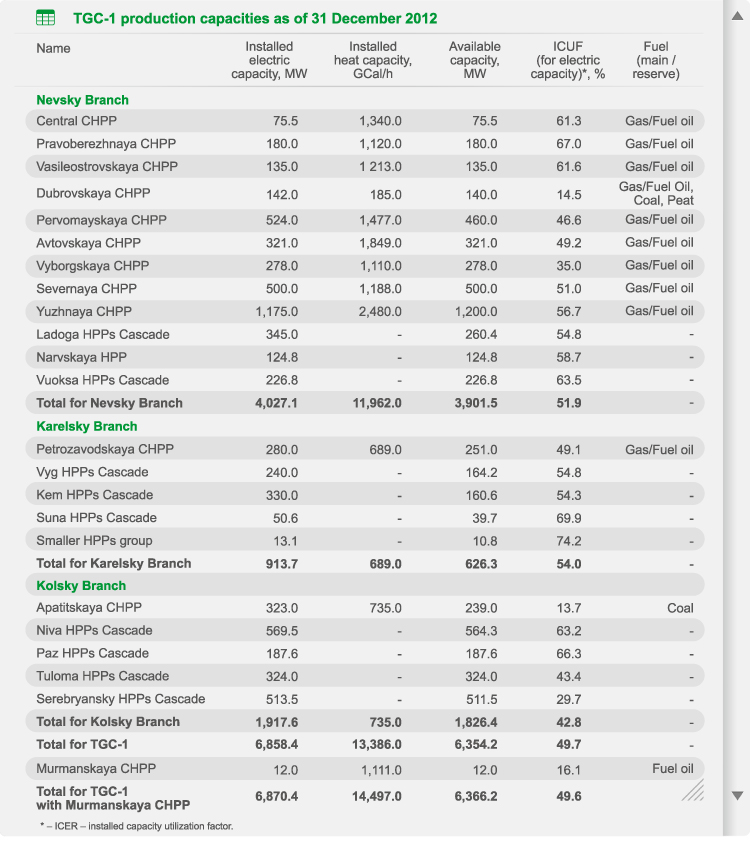
Installed capacity in 2012:
- decreased at the Dubrovskaya CHPP due to the decommissioning of turbine unit no. 1 with an installed capacity of 50 MW;
- changed at the Pervomayskaya CHPP due to the decommissioning of turbine units no. 1, 2, and 7 with a total installed capacity of 110 MW and the commissioning of a CCGT-180 unit with a capacity of 180 MW;
- increased at the Lesogorskaya HPP of the Vuoksa HPPs Cascade by 6 MW due to the remarking of hydroelectric unit no. 3 following modernization;
- increased at the Svetogorskaya HPP of the Vuoksa HPPs Cascade by 7.25 MW due to the remarking of hydroelectric unit no. 4 following modernization.
Available capacity in 2012:
- decreased at the Dubrovskaya CHPP due to the decommissioning of turbine unit no.1;
- increased at the Volkhovskaya HPP of the Ladoga HPPs Cascade due to the decrease in seasonal restrictions;
- increased at the Lesogorskaya HPP of the Vuoksa HPPs Cascade due to the remarking of hydroelectric unit no. 3 following modernization.

The overall installed electric capacity utilization factor for TGC-1 amounted to 49.7 %. The factor for HPPs is 52.6 % and for CHPPs it is 47.5 %.
Electricity Generation
In 2012, the volume of electricity generation by enterprises of TGC-1, including those of the Murmanskaya CHPP, increased by 7.1 % compared to 2011 and amounted to 30,388.3 million kWh.
Generation by TGC-1's Nevsky Branch increased by 4.3 %, Karelsky Branch by 32.5 %, and Kolsky Branch by 2.8 %. Generation by the Murmanskaya CHPP fell by 43.2 %. The increase in generation of electricity by CHPPs grew by 3.4 % from 2011, while HPPs' generation increased by 12.3 %.
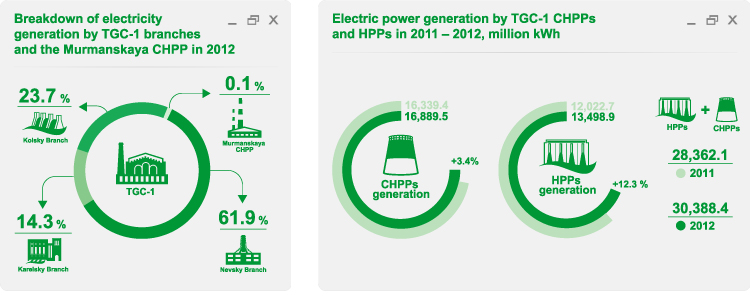
The high water content in the second half of the year had a favorable effect on the annual production volume, which was also increased due to the efficient operation of new power units and the launch of the second 180 MW CCGT-unit at the Pervomayskaya CHPP onto the wholesale market. Overall in 2012, the output of power units at the Yuzhnaya, Pervomayskaya and Pravoberezhnaya CHPPs amounted to 4,550.9 million kWh, or 15 % of overall output.
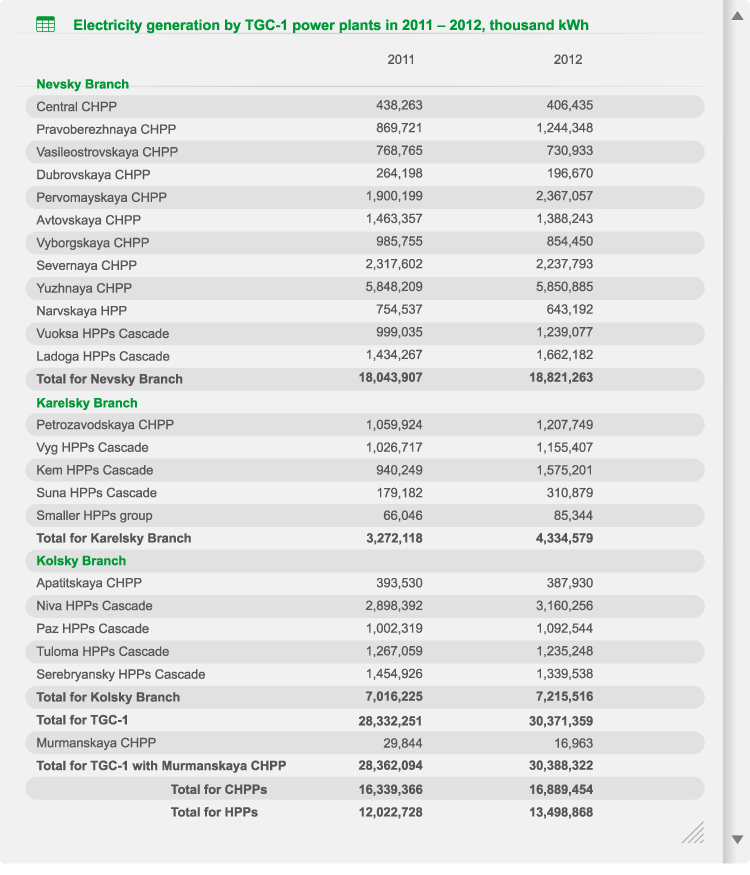
Hydrological conditions in regions where the Company operates. The influence of water content on the volume of electricity output
Nevsky Branch
In the Nevsky Branch area, the past year has generally been characterized by high water levels. The Vuoksa HPPs Cascade observed high water levels, at the Ladoga HPPs Cascade water levels increased, while the water levels at the Narvskaya HPP were close to average.
In 2012, the output of the Nevsky Branch was 3,544.5 million kWh, which is 11.2 % higher than in 2011. The increase in output is due to the general increase in water levels in the region relative to 2011.
Karelsky Branch
The inflow of water to all reservoirs in May 2012 was higher than the long-term average and amounted to 8 – 20 % of supply. At the end of summer 2012, territories of the Republic of Karelia experienced intense rainfall. Therefore, 2012 was in general characterized by high water content caused by rain floods. This allowed for water resources to accumulate in HPPs reservoirs and ensured that generation performance targets were met.
Output of the Karelsky Branch HPPs in 2012 was 3,126.8 million kWh, which is 41.3 % higher than performance in 2011. The increase is due to the rise in useful inflow at the HPP's reservoir.
Kolsky Branch
The total volume of annual inflow at the HPP's reservoir amounted to 59.05 km³ with 24 % reserves. Water resource reserves throughout 2012 exceeded long-term averages and the year was characterized by high water content.
Output of the Kolsky Branch HHPs in 2012 was 6,827.6 million kWh, which is 3.1 % higher than performance in 2011.
Heat Generation
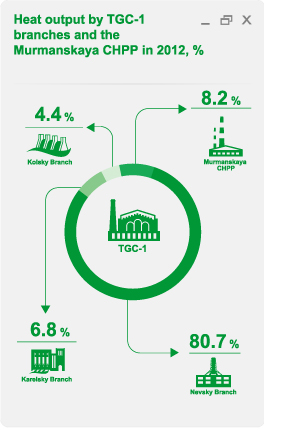
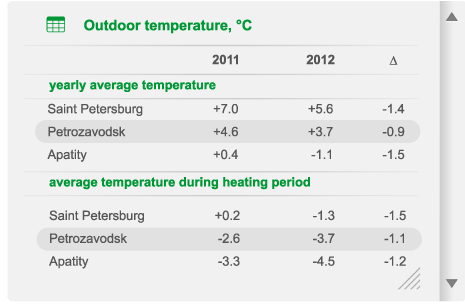
In 2012, the output of heat from the Company's facilities overall increased by 1.5 % compared to 2011, which can be attributed to lower temperatures during the heating season and amounted to 26,437.5 thousand GCal. Outputs by the Nevsky, Karelsky and Kolsky branches increased by 1.3 %, 8.5 % and 0.4 % respectively. The output of heat from the Murmanskaya CHPP was 1.0 % less than analogous figures for 2011.
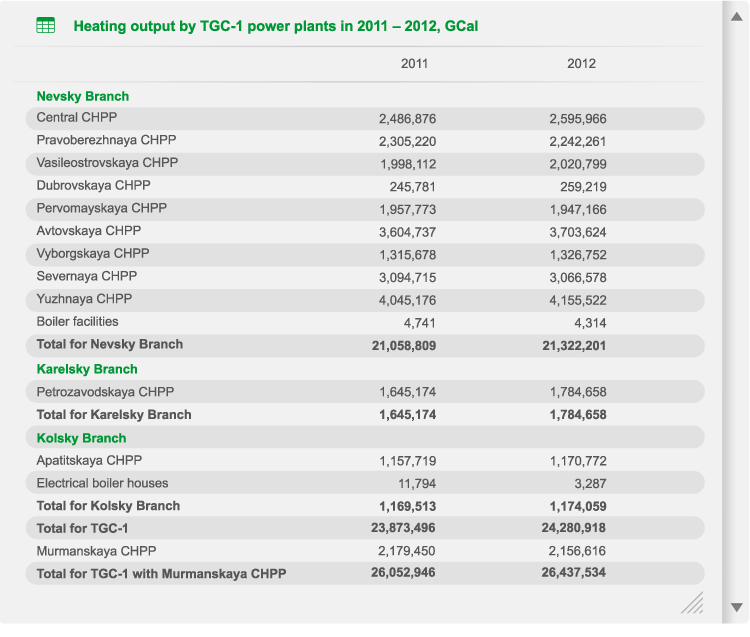
Analysis of Fuel Consumption by Company's CHPPs
The specific reference fuel consumption is the main parameter used for assessment of the fuel consumption at TGC-1's CHPPs. In 2012 overall, the Company's specific reference fuel consumption for delivered electricity amounted to 284.1 g/kWh, which is 2.6 % less compared to 2011. At the same time, the specific reference fuel consumption for delivered heating increased by 0.8 % to 139.8 kg/GCal.
Reduction of the Company's overall specific reference fuel consumption for delivered electricity was due to comissioning of new CCGT-units with lower reference consumption.
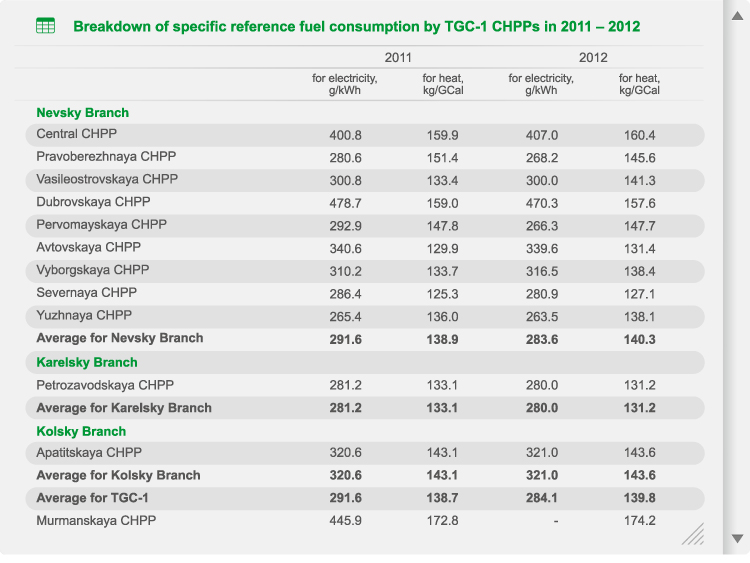
Energy Saving and Energy Efficiency
In 2012, TGC-1 passed and approved its Programme for Energy Conservation and Efficiency for 2012 – 2014. A total of 45 organizational and technical measures were taken at most of the Nevsky Branch CHPPs to improve energy efficiency and reduce technological and operational costs. The cumulative effect of these measures was 16,402 tons of fuil equivalent and 900 thousand kWh. The cumulative effect of measures taken at the Karelsky Branch amounted to 383 tons of oil equivalent and 1,203 kWh. Intermediate repair of boiler no. 1 was conducted at the Kolsky Branch's Apatitskaya CHPP, with an energy saving effect of 177 tons of oil equivalent.















